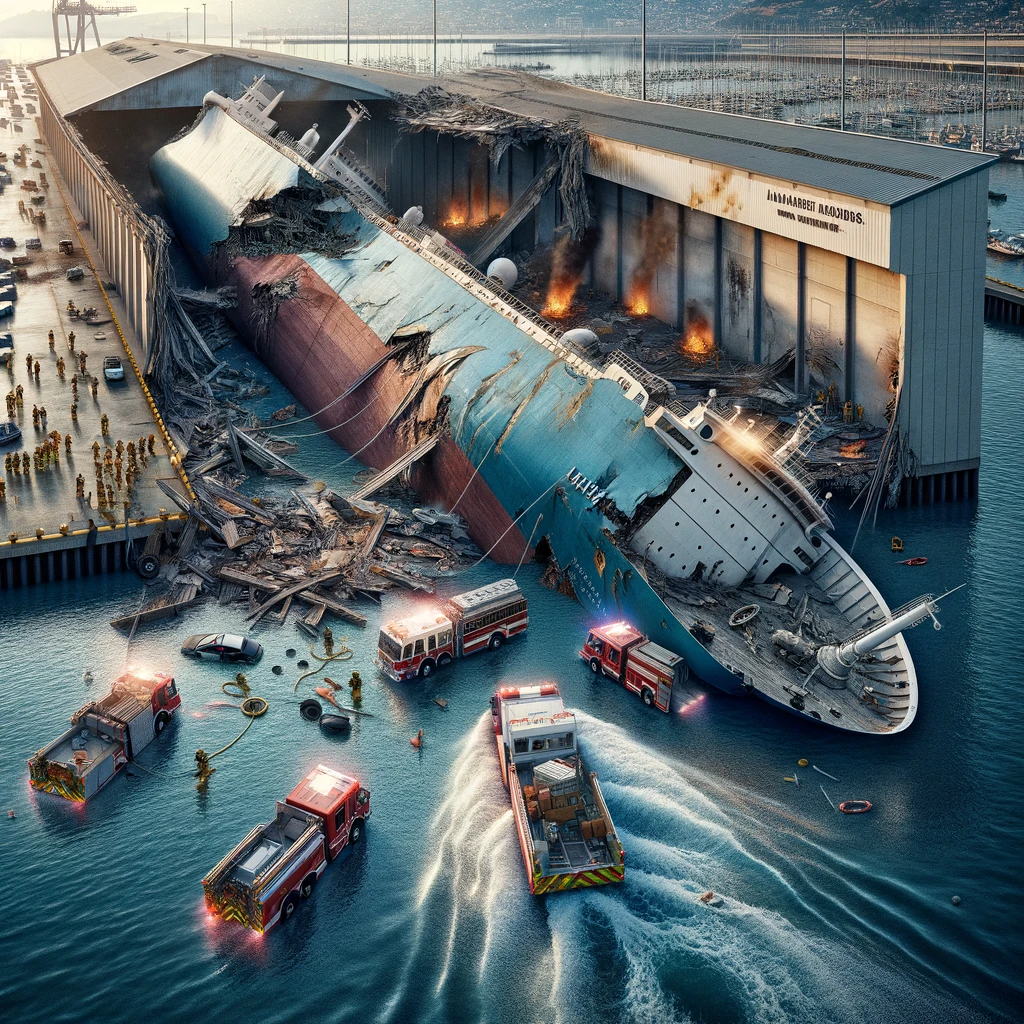In the realm of maritime law, allision damages arise from unfortunate incidents where a moving vessel makes forceful contact with a stationary object. Unlike collisions involving two moving vessels, allisions are defined by the striking of a fixed object, which can encompass a wide variety of structures. Docks, wharves, piers, jetties, bridge supports, navigational buoys, and even underwater pipelines all fall under the category of stationary objects that can be impacted in an allision incident.

These incidents are not confined to specific areas; they can occur across the full spectrum of navigable waters, from the vast expanse of open ocean and busy coastal areas to intricate inland waterways and bustling commercial ports. The legal framework governing allision damages addresses the complex aftermath of these events, focusing on establishing liability and ensuring fair compensation for the losses incurred.
Direct vs. Indirect Allision Damages: Categorizing the Losses
When a vessel allides with a stationary object, the resulting damages can be extensive and varied. Maritime law generally categorizes these losses into two primary types: direct and indirect damages. Direct damages primarily refer to the immediate and tangible physical harm sustained in the allision. This category encompasses the damage directly inflicted upon the vessels involved in the incident. This includes structural damage to the vessel’s hull, machinery, and equipment, as well as any damage or loss suffered by the cargo being carried onboard the vessel at the time of the allision.
Conversely, indirect damages represent the broader economic repercussions stemming from the allision, although not directly physical in nature. These indirect losses are primarily financial and include a range of economic harms. Lost profits, resulting from the vessel being out of service for repairs or delays in cargo delivery, are a significant component of indirect damages. Increased operational costs, such as expenses for alternative transportation arrangements, salvage operations, or extended port fees, also fall under this category. Understanding this distinction between direct physical damages and broader economic consequences is crucial in navigating the legal claims process following an allision.
Establishing Liability for Allision Damages: The Principle of Negligence
The determination of liability in allision damage cases is fundamentally rooted in the legal principle of negligence. To successfully pursue a claim for allision damages, the injured party, legally termed the plaintiff, bears the responsibility of demonstrating, through sufficient evidence, that the opposing party, the defendant, acted negligently. Under maritime law, establishing negligence requires fulfilling a specific legal test. Firstly, the plaintiff must prove that the defendant owed them a duty of care. In the context of vessel operation, this duty generally refers to the obligation to act reasonably to prevent harm to others.
Secondly, the plaintiff must demonstrate that the defendant breached this established duty of care. This means showing that the defendant’s actions or omissions fell below the accepted standard of reasonably prudent conduct within the maritime industry. Finally, and crucially, the plaintiff must provide evidence that their injuries and damages were a direct result of the defendant’s breach of duty. This establishes the necessary causal link between the negligent action and the harm suffered. Specifically, in the context of allision collisions, the legally defined duty of care unequivocally entails operating a vessel in a manner that is considered both safe and prudent. This broad obligation encompasses numerous practical considerations that prudent mariners must constantly evaluate. Factors such as prevailing and forecasted weather conditions, the density and patterns of maritime traffic in the area, the specific handling characteristics and limitations of the vessel being operated, and the presence of any known navigational hazards all fall under the umbrella of prudent navigation.
Therefore, if it can be demonstrated that a vessel operator failed to navigate their vessel in a safe and prudent manner, and this failure directly led to an allision collision and subsequent damages, that operator, and potentially their associated company, may be held legally responsible and financially liable for covering the ensuing damages under the established principles of maritime negligence.
Recovering Compensation for Allision Damages: Building Your Legal Claim
For a party who has unfortunately suffered damages resulting from an allision collision, the legal pathway to financial recovery involves diligently establishing the fault of the other vessel involved and convincingly demonstrating that the damages sustained were a direct and foreseeable consequence of that allision. Central to a successful claim is the meticulous gathering of compelling evidence to substantiate the legal arguments.
This crucial evidence gathering phase may involve securing detailed witness statements from individuals who observed the events leading up to, during, and after the allision. Photographic and video documentation of the damage sustained by both the vessel and the stationary object immediately after the incident is invaluable in providing visual proof of the harm. Expert testimony from maritime professionals, such as naval architects, marine surveyors, and accident reconstruction specialists, can provide crucial objective analysis of the incident and its causes.
Finally, relevant maritime records, including vessel logs, navigational charts, weather data, and communication records, can provide critical documentary evidence to support the claim and establish the sequence of events. If you find yourself in the unfortunate situation of having endured injuries or property damage due to an allision collision, you may have a legally protected opportunity to seek financial compensation from the party deemed to be legally responsible for causing the incident. Pursuing this compensation typically involves initiating a formal legal lawsuit against the at-fault party.
Successfully navigating the inherent complexities of allision damage claims absolutely necessitates a comprehensive understanding of the pertinent principles of maritime law. It also requires a proactive and unwavering commitment to diligently safeguarding your legal rights and financial interests in the aftermath of a collision incident. Seeking expert legal counsel from experienced maritime attorneys is strongly recommended to ensure the best possible outcome in such cases.
